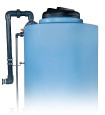Wastewater treatment is an extremely important part of making sure that humans treat the earth with respect. The proper treatment of wastewater is essential not only for the environment — due to the use of several chemicals throughout the process, a safe process also keeps employees and your facility safe.
Topics:
Applications
Twenty years ago, the availability of commercial grade cross-linked polyethylene (XLPE) for chemical storage tanks was limited to a small number of sources. The limited supply, as well as a wide variation in quality, made it challenging to find quality resin for chemical storage tanks.
Topics:
Value Added
Rather than settle for the industry standard, Poly Processing redefines the standard by developing fittings and tank accessories that clearly address our customers’ needs. By analyzing industry requirements and working directly with our customers, we gain the insights to develop specialized products that address real-life issues in the field.
Topics:
Fittings and Accessories
We get a lot of questions about the standard testing on chemical storage tanks that we do at our facility. Vertical tanks larger than 500 gallons in most cases are extensively tested to ensure that they meet ASTM standards. Depending on customers’ needs, we also offer additional testing on our chemical storage tank systems. Let's take a look at the types of chemical tank testing that Poly Processing performs, how we do it, and why these tests are so important in the chemical storage tank production process.
Topics:
Tank Design and Materials
Environmental stress cracking occurs in plastic tanks over time, under certain conditions. It’s a failure of the polymer material due to surface-initiated micro cracks or fractures. These micro cracks are caused by the combination of stresses and environmental effects.
Topics:
Value Added,
Tank Design and Materials,
FAQs
This is the second article in Poly Processing’s Innovation Series, where you’ll discover the many innovations that we have introduced to the chemical storage industry. One of the biggest challenges in vertical tank design is maintaining the tank’s integrity while still allowing for the tank to be fully discharged, cleaned, and properly maintained. Traditional tank maintenance can be a challenge with many chemicals — so Poly Processing Company has developed a unique full discharge system that helps minimize the hazards associated with traditional vertical tank maintenance.
Topics:
Fittings and Accessories
If the very first question your chemical tank supplier asks isn’t, “So, tell me, what kind of chemical are you storing in this tank?” they’re doing it wrong. The number one job for your tank supplier is to make sure you get the right chemical storage system for the chemical you’re using. If they don’t get that detail right, it can lead to serious risks and cost you thousands of dollars in additional costs.
Topics:
Value Added
One of the most popular chemicals in the market that Poly Processing crosslinked polyethylene tanks store is Hydrofluoric Acid. Not only is hydrofluoric acid a commonly used chemical, it's also one of the more dangerous chemicals in use. Safe and proper storage of this chemical is crucial.
Topics:
Chemicals,
IMFO
This is the first article in Poly Processing’s Innovative Solutions Series, where you’ll discover the many innovations that we have introduced to the chemical storage industry. Not all high-density polyethylene tanks are created equal. Although they sound nearly identical, high density polyethylene (HDPE) and cross-linked polyethylene (XLPE) chemical storage tanks have significant differences. Those differences could impact your organization’s bottom line, your people’s safety, and the operations of your facility.
Topics:
Value Added,
FAQs
Hydrofluorosilicic acid is a challenging chemical because it has properties that pose a danger and specific storage concerns. With its common use in water treatment, it is important to be aware of the risks of improperly storing this aggressive chemical. Let’s take a closer look at the nature of hydrofluorosilicic acid, its applications, the specific storage concerns and solutions, and safety considerations when working with this complicated chemical.
Topics:
Chemicals



